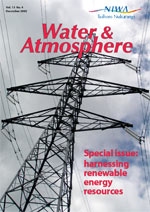PDF of this article (156 KB)


Wright volcano
An undersea volcano on the Kermadec Ridge, about halfway to Tonga and about 190 km southeast of Macauley Island, has been named after NIWA marine geologist Ian Wright.
Technically speaking, Wright is a 'volcanic centre', with two separate volcanic cones, covering about 290 km2 (about the size of Ngauruhoe volcano). Both cones rise over 1500 m, and appear to have collapsed repeatedly.
Wright volcano was discovered last year during a New Zealand-American expedition on RV Tangaroa. In April this year, Ian became the first (and so far the only) scientist to dive on this volcano, using the University of Hawaii’s Pisces V submersible.
In all, seven undersea volcanoes have been named by scientists at GNS Science in consultation with Land Information New Zealand (LINZ) and local Māori. Four volcanoes have been given Māori names: Hinepuia (guardian of geothermal activity), Rakahore (guardian of the layers that encrust the earth mother), Pūtoto (magma), and Hinetāpeka (guardian of the internal fires). In addition to Wright volcano, two others have been named after geologists known for their work on Kermadec volcanism: Professor John Gamble (previously at Victoria University, now at Cork University, Ireland); and Professor Jim Cole (University of Canterbury).
For further information, contact: Dr Ian Wright, 0-4-386 0322, [email protected]
Update on UV radiation and its effects
A three-day workshop in April will be a forum for discussion and an opportunity to meet others involved in UV research. By its nature, the study of UV radiation crosses many disciplines, including atmospheric chemistry and physics, botany, zoology, materials science, and health. UV and its effects are also of interest to policy advisers, manufacturers, and the media.
The workshop will include panel discussions to identify future needs for research in this area. It is sponsored by the Royal Society of New Zealand and the Cancer Society of New Zealand. It follows on from three very successful UV workshops held in 1993, 1997, and 2002.
Abstracts from the papers presented will be incorporated without editing into a Summary Report, which will include a bibliography of recent research into UV radiation and its effects in New Zealand.
When: 19-21 April 2006 Where: Otago Museum, Dunedin Further information: www.niwascience.co.nz/rc/atmos/uvconference/ or contact: Richard McKenzie, 0-3-440 0429, [email protected]
Fresh look for NIWA websites
In keeping with our growing company, we've expanded the NIWA websites in scope and number. A new NIWA Group entry page leads to all the sites, including NIWA Science and our New Zealand and overseas subsidiaries.
With its new look and enhanced navigation, the NIWA Science site incorporates most of the material of our original website, a wealth of information that has been growing for over a decade. And it’s still the home for the online version of Water & Atmosphere, which now contains a five-year archive of issues.
www.niwa.co.nz now takes you to the NIWA Group website, which includes a link to NIWA Science at www.niwascience.co.nz.
For further information, contact: Ryan Lea, 0-7-859 1865, [email protected]
